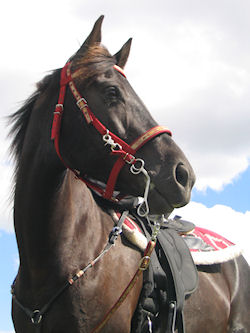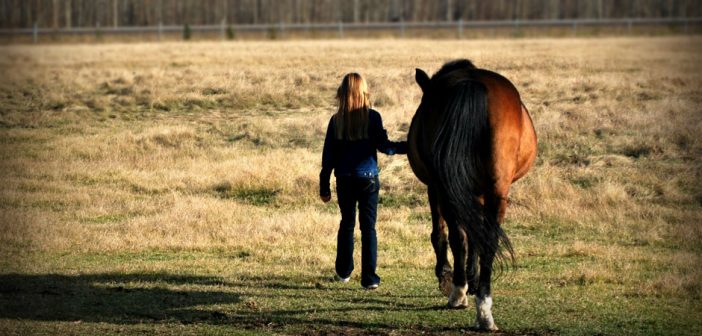Working with horses on the ground can be just as dangerous as riding, with the possibility of a horse stepping on or knocking over their handler. Here are some tips on how to safely lead your horse on the ground:
The Halter & Lead Rope
Begin with your horse haltered with a sturdy lead rope snapped to the ring on the underside of the halter. Never lead your horse by holding the halter, your hand could get stuck if the horse tosses his head, gets spooked, or takes off running. Having a good, comfortable halter and lead rope is essential for ground work.
We particularly like rope halter and lead combos like this one from Amazon, where it’s one, knotted piece. There’s no hardware that can break and horses seem to be quite comfortable so long as the halter is tied correctly. Also make sure you base the length of the lead on the size of your horse and what you are doing to avoid having too much, or too little, lead rope. Lead ropes are typically between 8 and 14 feet long. The Weaver combo pictured here has a 10-foot lead which is a great length for general use, including walking your horse. If you are doing groundwork, you’ll probably want a longer lead (12 to 14 feet).
Holding the Lead Rope
To ready yourself for the walk, hold the lead rope in your right hand approximately 12 to 18 inches below the clasp. Hold the remainder of the lead folded up in your left hand. Do NOT wrap the excess lead rope around your hand thinking you’ll have a better grip. You must be able to let go of the lead rope quickly if necessary. Don’t allow the remainder of the rope to drag on the ground either. You, your horse, or both of you certainly don’t need to be tripping over or becoming entangled with the lead rope.
Walking Your Horse
Stand in the direction you want to go and cue your horse forward by clicking, or kissing, or simply telling your horse to “walk.” I once had a riding friend who would spur her horse on by telling her to “have a go.” Gently tug on the lead rope and move forward assertively and release pressure as soon as the animal moves forward. Look forward as you walk, don’t look at your horse. You need to see where you’re going and you don’t want to show any sign of aggression that may startle the horse or make him move away. Tug the lead rope if the horse walks too fast or tries to walk away.
If the horse stops, repeat the process. Whatever you give for a verbal cue to initiate movement, just be consistent and your horse will catch on quickly. And remember your position, it’s important for your safety. Keep a couple of feet between you and your horse at all times. Keep your shoulder between the horse’s shoulder and head, never head or behind.
If you have difficulty getting your horse to move forward in the first place, try pulling him slightly to the right so he has to take a step with his left fore foot to re-balance. Then pull him gently back towards you so he has to move his right foot forward to again re-balance. Sometimes this actually encourages a reluctant horse to move.
Stopping Your Horse
To stop your horse, say “whoa” (or whatever verbal cue you choose) and stop walking. A little backward tug on the lead rope can also cue the animal to stop. If your horse wants to keep walking and is slow to respond to stop commands, try walking towards a fence or a solid object and, just as you come upon it, repeat your command and stop walking.
 Please remember, your horse is much stronger than you are! If he becomes startled and attempts to run, let go of him. If you attempt to hang on to the lead rope you may put yourself in danger. The horse can always be caught again.
Please remember, your horse is much stronger than you are! If he becomes startled and attempts to run, let go of him. If you attempt to hang on to the lead rope you may put yourself in danger. The horse can always be caught again.
Behavior on the ground often carries over to riding. If your horse shows respect towards you on the ground, he will more often than not be good under the saddle. Both you and your horse need your space. Crowding might alarm your horse and cause him to feel anxious. Patting and praising your horse reinforces good behavior.
Remember the importance of your horse respecting and trusting you.
The lead rope is not leading your horse, you are!






5 Comments
I think it is important to not stand directly behind the horse either because if spooked they could give you a swift kick.
I am glad that you posted this. A lot of people who are not experienced with horses believe they can just walk up to them and have a go. Another tip is if you are inexperienced with that particular horse is to lead them around in an arena. It is free of some of the distractions and will help you learn. If that is not possible, an enclosed area like a paddock, where the horse can’t escape if you drop the lead, but where you could duck under a fence, if you had to is another good option.
HoundsGood – great point! I have to admit I’ve ducked under my fair share of farm fences.
Very good advice, I would also be aware of any blowing paper, loud noised etc. that could scare him, which would distract him from you. Always be prepared.
Great tips for the inexperienced horse person. And I agree with Catherine, always be prepared, and PAY ATTENTION. Even the oldest, calmest, most predictable horse can jump on you.